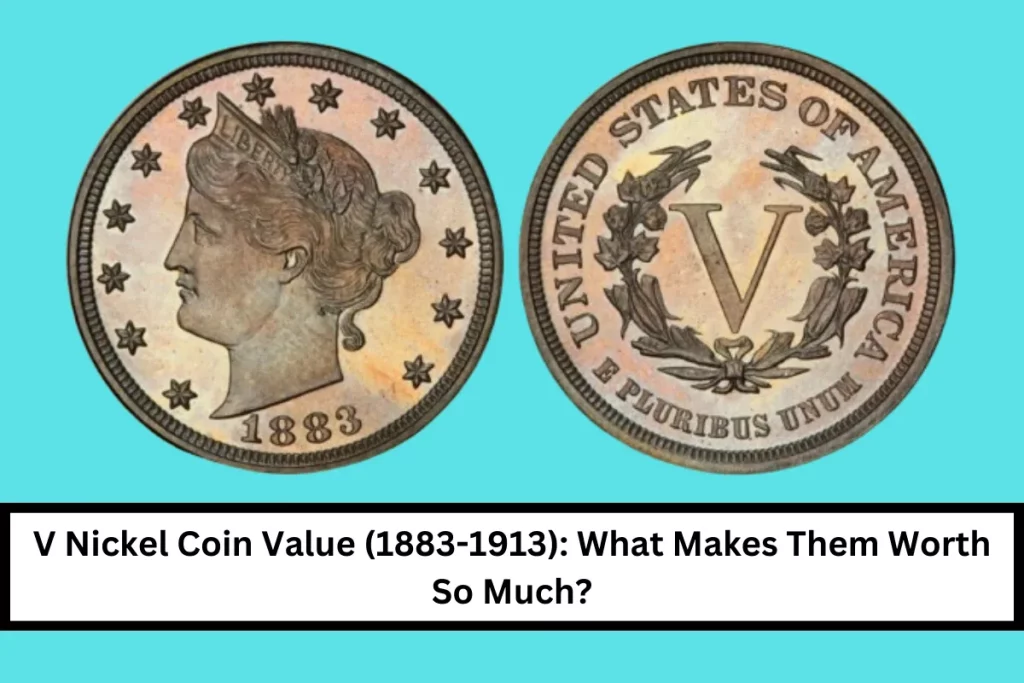The V Nickel coin, minted between 1883 and 1913, holds a special place in numismatic history. These coins are known for their distinct design, which includes a prominent “V” on the reverse side, symbolizing the Roman numeral for 5. Today, they are sought after by collectors and investors alike due to their rarity, historical significance, and varied value. In this article, we will explore the factors that influence the value of V Nickel coins from 1883 to 1913 and provide insights into their collectible worth.
What is the V Nickel Coin?
The V Nickel coin was introduced in 1883 as a replacement for the older Liberty Head nickel. The coin features a profile of Lady Liberty on the obverse and a large “V” on the reverse, representing the five-cent denomination. While the design was relatively simple, the coin became famous for its striking imagery and the controversy surrounding the initial release.
Key Features of the V Nickel Coin
- Year of Minting: 1883 to 1913
- Denomination: Five cents
- Material: Primarily made of nickel, with some copper
- Size: 21.2 mm in diameter
- Weight: 5 grams
These basic features helped define the coin’s role in American currency during its production years.
Factors Affecting V Nickel Coin Value
The value of the V Nickel coin varies widely based on several key factors. Understanding these factors will help collectors and investors better assess the worth of their coins.
1. Condition and Grading
The condition of the coin plays a significant role in determining its value. Coins in excellent condition are more valuable than those with wear and tear. Coins are graded on a scale from Poor (P-1) to Mint State (MS-70). The higher the grade, the higher the value.
- Mint State: Coins that appear almost as new
- Very Fine: Coins showing minimal wear
- Good: Coins with significant wear and damage
2. Rarity of the Year
Certain years of the V Nickel coin are rarer than others, which directly impacts their value. For example, the 1885 and 1913 coins are considered particularly rare due to limited mintage numbers. The 1913 V Nickel, often referred to as the “1913 Liberty Head nickel,” is one of the most famous and valuable coins in American numismatics.
3. Special Varieties and Errors
Error coins or coins with unique varieties can also command higher prices. In 1883, for example, the V Nickel was mistakenly minted without the word “CENTS” on the reverse. This error caused a surge in demand for the coin, and these rare versions are now worth far more than their standard counterparts.
4. Market Demand
The demand for V Nickel coins fluctuates based on the current state of the numismatic market. When demand is high, coin values tend to increase. This is particularly true for well-known coins like the 1913 Liberty Head nickel, which has made headlines due to its astronomical auction prices.
How to Determine the Value of Your V Nickel Coin
Determining the value of your V Nickel coin requires examining various aspects, such as the year, condition, and rarity. Here are some steps to help you assess the value:
1. Identify the Year and Mintmark
The first step is identifying the year your coin was minted and any mintmarks that may be present. Mintmarks, typically located beneath the “V” on the reverse side, indicate where the coin was produced. This can have a significant impact on the coin’s value.
- No Mintmark: Philadelphia Mint
- D Mintmark: Denver Mint
- S Mintmark: San Francisco Mint
2. Assess the Condition
Use a coin grading guide to assess the condition of your V Nickel. If you are unsure about the grade, consider consulting a professional numismatist or submitting the coin for grading by a trusted agency like the Professional Coin Grading Service (PCGS).
3. Research Market Trends
Check the current market trends and auction results to see how much similar V Nickel coins have sold for. Online auction sites, coin dealers, and numismatic publications are great resources for finding current prices.
V Nickel Coin Value (1883-1913): Price Range
The value of a V Nickel coin can range widely depending on its year, condition, and rarity. Below are some approximate price ranges for common and rare V Nickels:
Common V Nickel Coins (1883-1913)
- 1883 V Nickel (no cents): $10 – $100 (in lower grades)
- 1900-1909 V Nickels: $5 – $40 (depending on grade)
Rare V Nickel Coins
- 1885 V Nickel: $200 – $500 (in higher grades)
- 1913 Liberty Head Nickel: $1 million or more (depending on condition)
Collecting V Nickel Coins
Collecting V Nickel coins can be an exciting and rewarding hobby. If you are new to coin collecting, consider starting with more common dates and gradually expanding your collection to include rarer coins. Many collectors focus on acquiring coins from each minting year, while others specialize in coins with unique features or historical significance.
FAQs
1. What is the value of a 1913 V Nickel?
The 1913 V Nickel is worth a significant amount, with examples selling for over a million dollars at auction.
2. Are all V Nickels valuable?
Not all V Nickels are valuable, but those in good condition or from rare years can be worth much more.
3. How do I grade a V Nickel coin?
You can grade a V Nickel coin based on its wear, appearance, and condition, using a professional grading guide or submitting it for official grading.
4. What makes the 1883 V Nickel valuable?
The 1883 V Nickel without the word “CENTS” on the reverse is a rare error coin, making it more valuable.
5. How can I sell my V Nickel coin?
You can sell your V Nickel coin through coin dealers, online auction platforms, or numismatic shows.

